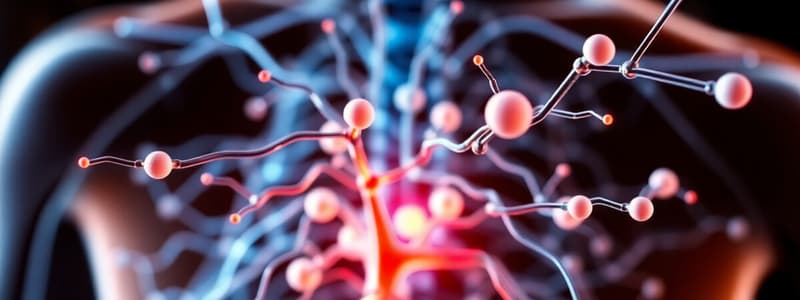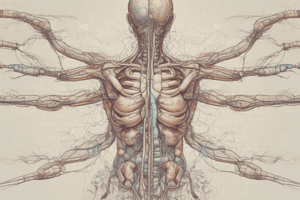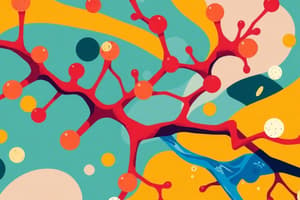Podcast
Questions and Answers
What distinguishes the presynaptic neurons of the parasympathetic nervous system?
What distinguishes the presynaptic neurons of the parasympathetic nervous system?
- They release norepinephrine as a neurotransmitter.
- They have shorter axons than postsynaptic neurons.
- They originate from the medulla oblongata and sacral spinal cord. (correct)
- They are located only in the thoracic region.
Which of the following correctly describes the role of the sympathetic nervous system?
Which of the following correctly describes the role of the sympathetic nervous system?
- It decreases heart rate and blood pressure.
- It elicits the 'fight or flight' response. (correct)
- It suppresses bodily functions during rest.
- It promotes digestion and nutrient absorption.
What is the function of postsynaptic neurons in the parasympathetic nervous system?
What is the function of postsynaptic neurons in the parasympathetic nervous system?
- They conduct impulses back to the central nervous system.
- They synapse directly with the presynaptic neurons.
- They typically have very long axons compared to presynaptic neurons.
- They transmit impulses to target organs after receiving them from presynaptic neurons. (correct)
Where are the parasympathetic ganglia typically located?
Where are the parasympathetic ganglia typically located?
Why are parasympathetic pathways referred to as cholinergic pathways?
Why are parasympathetic pathways referred to as cholinergic pathways?
What is the main function of the autonomic nervous system (ANS)?
What is the main function of the autonomic nervous system (ANS)?
Which of the following are components of the autonomic nervous system?
Which of the following are components of the autonomic nervous system?
The sympathetic and parasympathetic systems can be described as complementary systems.
The sympathetic and parasympathetic systems can be described as complementary systems.
What neurotransmitter is primarily used in parasympathetic pathways?
What neurotransmitter is primarily used in parasympathetic pathways?
The presynaptic neurons of the parasympathetic system are located within the ______ and sacral spinal cord.
The presynaptic neurons of the parasympathetic system are located within the ______ and sacral spinal cord.
What role does acetylcholine (ACh) play in muscle movement?
What role does acetylcholine (ACh) play in muscle movement?
What enzyme is responsible for the synthesis of acetylcholine?
What enzyme is responsible for the synthesis of acetylcholine?
Acetylcholine binds to both nicotinic and muscarinic receptors.
Acetylcholine binds to both nicotinic and muscarinic receptors.
What is the function of acetylcholinesterase?
What is the function of acetylcholinesterase?
How does acetylcholine affect heart rate?
How does acetylcholine affect heart rate?
Flashcards
Autonomic Nervous System (ANS)
Autonomic Nervous System (ANS)
Part of the peripheral nervous system (PNS) that controls internal organ functions, like heart rate, blood pressure, and digestion.
Parasympathetic Nervous System
Parasympathetic Nervous System
Branch of ANS that promotes "rest and digest" functions; its pathways utilize acetylcholine.
Cholinergic Pathways
Cholinergic Pathways
Parasympathetic pathways that use acetylcholine as a neurotransmitter.
Presynaptic Neuron
Presynaptic Neuron
Signup and view all the flashcards
Acetylcholine (ACh)
Acetylcholine (ACh)
Signup and view all the flashcards
Parasympathetic Nervous System
Parasympathetic Nervous System
Signup and view all the flashcards
Cholinergic Pathways
Cholinergic Pathways
Signup and view all the flashcards
Acetylcholine (ACh)
Acetylcholine (ACh)
Signup and view all the flashcards
Nicotinic Receptors
Nicotinic Receptors
Signup and view all the flashcards
Muscarinic Receptors
Muscarinic Receptors
Signup and view all the flashcards
Synaptic Cleft
Synaptic Cleft
Signup and view all the flashcards
Acetylcholinesterase
Acetylcholinesterase
Signup and view all the flashcards
Presynaptic Neuron
Presynaptic Neuron
Signup and view all the flashcards
Postsynaptic Neuron
Postsynaptic Neuron
Signup and view all the flashcards
Cholinergic System Drugs
Cholinergic System Drugs
Signup and view all the flashcards
Study Notes
Autonomic Nervous System (ANS)
- The ANS is a branch of the peripheral nervous system (PNS)
- It regulates visceral functions (e.g., organs)
- It innervates smooth muscle and glands
- Divided into parasympathetic and sympathetic systems
Cholinergic System Drugs
- The cholinergic system uses acetylcholine as a neurotransmitter
- The parasympathetic nervous system is also known as the cholinergic system
- It plays a role in many bodily functions including heart rate, blood pressure, digestion, and more
- The sympathetic nervous system can be thought of as having opposing actions to the parasympathetic
- The sympathetic nervous system uses norepinephrine
Cholinergic Agonists
- These drugs mimic the action of acetylcholine
- Examples include bethanechol, carbachol, pilocarpine, and nicotine
Cholinergic Antagonists
- These drugs block the action of acetylcholine
- Examples include atropine, scopolamine, and others
Anticholinesterase Drugs
- These inhibit the breakdown of acetylcholine, increasing its concentration
- They are used to treat conditions like myasthenia gravis
- Examples include physostigmine, neostigmine, and others
Muscarinic Receptors
- These are receptors that acetylcholine binds to
- Different types of receptors exist (M1-M5)
- These receptors mediate various functions throughout the body
Nicotinic Receptors
- These are other receptors that acetylcholine binds to
- These are found in the autonomic nervous system (ANS)
- They regulate muscle/movement (and more)
Effects of Drugs on Cholinergic Transmission
- Cholinergic agonists mimic acetylcholine's effects
- Cholinergic antagonists block acetylcholine's effects
- Anticholinesterase drugs inhibit enzymes that break down acetylcholine
Myasthenia Gravis
- A chronic autoimmune disorder
- Skeletal muscle weakness is a symptom of this disease
- Antibodies interfere with acetylcholine receptors
- It's treated with medications like cholinesterase inhibitors
Studying That Suits You
Use AI to generate personalized quizzes and flashcards to suit your learning preferences.




